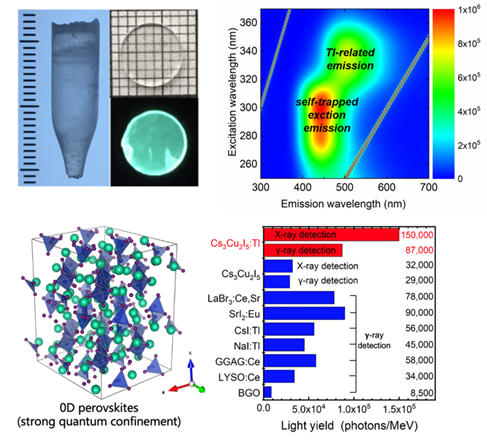Scientists Propose and Design a Series of Low Dimensional Perovskite Metal Halide Scintillators
Scintillators have been widely used in nuclear medical imaging, homeland security, high-energy physics and other fields as core materials of radiation detectors. The novel scintillation crystals with high light yield and high energy resolution is in urgent need to meet the sensitivity and confidence requirements of high-performance γ-ray detection.
Several low dimensional perovskite metal halide materials have been considered as potential high-performance scintillators. These materials exhibit intense confined excitons emission, large Stokes shift and high photoluminescence quantum efficiency, having the advantages of no self-absorption and high luminescent efficiency.
Recently, the research group led by Prof. WU Yuntao from the Shanghai Institute of Ceramics proposed and designed a series of low dimensional perovskite metal halide scintillators with strong self-trapped excitons emission, based on the academic thought of functional groups ordering. These scintillation single crystals were grown by the Bridgman method and exhibited no hygroscopicity, low melting point, high radiation stopping ability, high light output, high energy resolution and low afterglow. The confined excitons scintillation mechanism was revealed through experiments and theoretical calculations.
One-dimensional perovskite structured CsCu2I3 crystal has the advantages of high density (5.01 g/cm3), high effective atomic number (Zeff =50.6), low melting point (371 ℃), no hygroscopicity and no self-absorption. The luminescence center is the self-trapped exciton state localized in [Cu2I6]4- polyhedral, and the emission peak is at 570 nm. CsCu2I3 crystal has extremely low X-ray excitation afterglow (only 0.008% at 10 ms), which is four orders of magnitude lower than that of commercial CsI:Tl crystal.
Although its light output is 16,000 ph./MeV at room temperature, it could reach 100,000 ph./MeV at 200 K, which is close to its theoretical light output. Through experimental characterization including temperature depended photoluminescence spectra and decay times measurements, it is found that the decrease in light output is caused by the thermal decomposition of its exciton state at room temperature. These results were published in ACS Appl. Mater. Interfaces with the title of “Non-hygroscopic, self-absorption free, efficient 1D CsCu2I3 perovskite single crystal for radiation detection”.
Zero-dimensional perovskite structured Cs3Cu2I5 crystal features high density (4.52 g/cm3), high effective atomic number (Zeff =52.2), low melting point (383 ℃), no hygroscopicity and no self-absorption. Compared with CsCu2I3 of one-dimensional structure, Cs3Cu2I5 has a higher photoluminescence quantum efficiency (up to 69.9%). The light output under X-ray and γ-ray excitation could reach 30,000 ph./MeV, and it has an excellent energy resolution (3.4% at 662 keV). These results were published in Phys. Status Solidi RRL with the title of “Zero-dimensional Cs3Cu2I5 perovskite single crystal as sensitive X-ray and g-ray scintillator”.
Based on the research of the zero-dimensional perovskite Cs3Cu2I5 crystal, the team optimized the doping of Tl+ and developed the Cs3Cu2I5:Tl crystal. In Cs3Cu2I5:Tl crystal, there is Tl+ bound excitons emission at 510 nm in addition to the self-trapped excitons emission of [Cu2I5]2- polyhedral at 445 nm. Compared with the undoped Cs3Cu2I5 crystal, the photoluminescence quantum efficiency of the Cs3Cu2I5:Tl crystal is increased from 69.9% to 79.2%. The light output of this material can reach 150,000 ph./MeV under X-ray excitation, which is the highest one among known scintillators. Its X-ray detection limit is extremely low of 66.3 nGyair/s, which is only 1/83 of the X-ray diagnostic requirement (5.5 mGyair/s). The g-ray excitation light output of Cs3Cu2I5:Tl crystal can be increased to 87,000 ph./MeV and an excellent energy resolution of 3.4% at 662 keV is reserved.
Through theoretical calculations, temperature depended photoluminescence spectra and decay times measurements, it is found that the mechanism of its scintillation performance improvement mainly comes from two points. Firstly, the Tl0 or Tl2+ Coulomb field that may be formed after Tl+ doping increases the attraction of electrons and holes to improve the formation probability of self-trapped exciton states. Secondly, The Tl+ bound exciton state formed after Tl+ doping provides an additional radiation transition center and improves the luminescent efficiency. These results were published in Advanced Optical Materials with the title of “Ultra-bright and highly efficient all-inorganic zero-dimensional perovskite scintillators”.
These works were supported by the National Natural Science Foundation of China, the Original Exploration Project of Shanghai Natural Science Foundation, the High-tech Field Project of Shanghai Science and Technology Commission, and the Zhangjiang Major Project, etc.
Reference:
https://pubs.acs.org/doi/10.1021/acsami.0c22505
https://onlinelibrary.wiley.com/doi/10.1002/pssr.202000374
https://onlinelibrary.wiley.com/doi/abs/10.1002/adom.202100460

(a) Single crystal sample of CsCu2I3, (b) One-dimensional structure of CsCu2I3, (c) Temperature depended photoluminescence emission spectra of CsCu2I3, (d) Temperature depended photoluminescence emission intensities and decay times of CsCu2I3.

(a) Single crystal sample of Cs3Cu2I5:Tl, (b) Photoluminescence excitation and emission spectra of Cs3Cu2I5:Tl, (c) Zero-dimensional structure of Cs3Cu2I5, (d) Comparison of light outputs of Cs3Cu2I5, Cs3Cu2I5:Tl and other commercial scintillation crystals.
Contact:
Prof. WU Yuntao
Shanghai Institute of Ceramics
Email: ytwu@mail.sic.ac.cn



